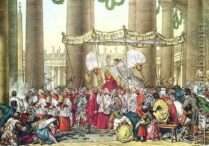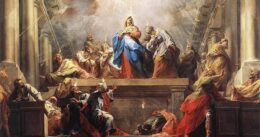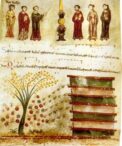There is a general principle that says that if the faithful are unable to attend Mass on a given feast, the Mass for that feast can also be celebrated on the following Sunday. This provision is referred to as an external solemnity. You will recall that we did this for the Feast of the Ascension.
Universally, there are two feasts which may always be solemnized in this way, simply at the discretion of the priest. They are the Feast of the Holy Rosary and the Feast of the Sacred Heart. In 1885, an Apostolic Indult was granted to the Catholic hierarchy of the United States allowing the Mass and Procession for the Feast of Corpus Christi to be held on the Sunday following the Feast. Corpus Christi, always on the Thursday after Trinity Sunday, was last week. Thus, on this Sunday, we had the Mass and procession of Corpus Christi in lieu of the Mass of the Second Sunday after Pentecost.
There is something else that we had to consider. It is also now June, month of the Sacred Heart.
We started with the hymn Hail True Victim as processional. This is rather a standard in the repertoire for the Blessed Sacrament.
We are no longer in Paschaltide, and so we did the Asperges, followed by Cibavit, the Introit of the Feast.
We’ve covered in the past how there is a correlation between the color of the priest’s vestments and the Kyriale. Father wore gold today. The liturgical color for the feast is white. Gold is generally used in lieu of white for more solemn feasts, and so Mass II (For Solemn Feasts) is particularly fitting. Typically, if Father is wearing Gold, we will sing Mass II.
There is no liturgical relationship between the Kyriale (Kyrie, Gloria, Sanctus, and Agnus Dei) and the Credo. Today, we rather arbitrarily selected Credo III.
Given that we are no longer in Paschaltide, we sang a Gradual followed by an Alleluia. And, today was once again one of only five masses at which a Sequence is sung. These are the five:
1. Pentecost Veni Sancte Spiritus
2. Corpus Christi Lauda Sion
3. Our Lady of Sorrows Stabat Mater
4. Easter Victimae Paschali Laudes
5. Requiem Dies Irae
Today’s particularly beautiful Sequence was composed by the great Doctor of the Holy Eucharist, Saint Thomas Aquinas. In 1264, he and Saint Bonaventure were challenged by Pope Urban IV to compete in writing the propers for the newly-instituted Feast of Corpus Christi. When Bonaventure heard what Thomas had written, he simply tore up his own work, folded his hand, and conceded the victory to Saint Thomas.
At the Offertory, it is customary to sing a hymn in honor of Our Lady. We sang Ave Verum. This is a lovely hymn in honor of the Blessed Sacrament, but it is also very Marian in character, casting the Blessed Sacrament as, born of the Virgin Mary, and son of Mary.
Hail, true Body, born of the Virgin Mary,
having truly suffered, sacrificed on the cross for mankind,
from whose pierced side water and blood flowed:
Be for us a foretaste [of the Heavenly banquet] in the trial of death!
O sweet Jesus, O holy Jesus, O Jesus, son of Mary,
have mercy on me. Amen.
For the Communion, we sang the great classic for this month of the Sacred Heart, Cor Arca.
Given the procession to immediately follow Mass, rather than sing Ite Miss Est, Father sang Benedicamus Domino. There was no last Gospel. We sang O Salutaris Hostia, also written by Saint Thomas, as Father incensed the Blessed Sacrament. And then, as is customary, as the procession commenced, we sang the first four verses of the Pange Lingua, also written by Saint Thomas Aquinas!
During the procession, we sang Holy God we Praise Thy Name. As we approached the outdoor altar, we reprised the Pange Lingua,then continued with the last two verses, which are often sung as a separate hymn, the Tantum Ergo.
There is a very special provision for what took place next. After the Tantum Ergo, the following versicle and response are sung:
℣ Panem de caelo praestitisti eis.
℟ Omne delectamentum in se habentem.
During Paschaltide, these are each succeeded by the word alleluia. Extraordinarily, that is also done on this special feast of the Holy Eucharist.
Returning to the Church, we sang To Jesus Christ Our Sovereign King, and Hail Holy Queen Enthroned Above, to honor the respective Kingship and Queenship of Our Lord and Our Lady.
As the Benediction ceremony resumed inside the Church, we sang the prayer for the Pope, Oremus pro Pontifice. And in preparation for the second Benediction, we again sang the Tantum Ergo, but according to a different melody. We then again sang the versicle and response, once again with the alleluias.
We concluded the benediction ceremony with Adoremus in Aeternum, another great classic in honor of the Blessed Sacrament and a fitting hymn for the beautiful External Solemnity of Corpus Christi.









